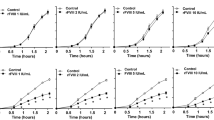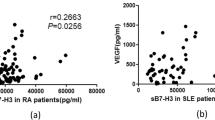Abstract
Severe plasma ADAMTS13 deficiency results in the clinical disorder thrombotic thrombocytopenic purpura. However, other potential pathophysiological roles of ADAMTS13 in endothelial cell biology remain unexplored. The goals of this study were to understand the angiogenic pathways ADAMTS13 activates and to identify the important structural components of ADAMTS13 that stimulate angiogenesis. Incubation of human umbilical vein endothelial cells (HUVEC) with 150 ng/mL (1 nM) of recombinant human ADAMTS13 induced VEGF expression by 53 % and increased VEGF mRNA by over sixfold, both within 10 min; the measured VEGF levels steadily decreased over 2 h, as shown by Western blot and ELISA. Phosphorylation of VEGFR2 was significantly enhanced in HUVEC after incubation with ADAMTS13 (1 nM). Structure–function analysis showed that an ADAMTS13 variant containing thrombospondin type 1 (TSP1) 2–8 repeats (TSP1 2–8), TSP1 2–8 plus CUB domains (TSP1 2–8 plus CUB), or TSP1 5–8 repeats plus CUB domains (TSP1 5–8 plus CUB) increased HUVEC proliferation by 41–54 % as compared to the EBM-2 controls. Chemotaxis assays further demonstrated that the TSP1 domains of ADAMTS13 increased HUVEC migration by 2.65-fold. Incubation of HUVEC with both ADAMTS13 variants containing TSP1 repeats and anti-VEGF IgG abrogated the enhanced effect of ADAMTS13 on proliferation, migration, and VEGFR2 phosphorylation. In conclusion, ADAMTS13-induced endothelial cell angiogenesis occurs via the upregulation of VEGF and phosphorylation of VEGFR2. This angiogenic activity depends on the C-terminal TSP1 repeats of ADAMTS13.




Similar content being viewed by others
References
Furlan M, Robles R, Lammle B (1996) Partial purification and characterization of a protease from human plasma cleaving von Willebrand factor to fragments produced by in vivo proteolysis. Blood 87:4223–4234
Tsai H-M (1996) Physiologic cleavage of von Willebrand factor by a plasma protease is dependent on its conformation and requires calcium ion. Blood 87:4235–4244
Green D, Muller H (1978) Platelet-binding of the von Willebrand factor. Thromb Haemost 39:689–694
Senogles S, Nelsestuen G (1983) Von Willebrand factor. A protein which binds at the cell surface interface between platelets. J Biol Chem 258:12327–12333
Sadler J (2008) Von Willebrand factor, ADAMTS13, and thrombotic thrombocytopenic purpura. Blood 112:11–18
Tao Z, Want Y, Choi H et al (2005) Cleavage of ultralarge multimers of von Willebrand factor by C-terminus-truncated mutants of ADAMTS-13 under flow. Blood 106:141–143
**ao J, ** S, Xue J et al (2011) Essential domains of a disintegrin and metalloprotease with thrombospondin type 1 repeats-13 metalloprotease required for modulation of arterial thrombosis. Arterioscler Thromb Vasc Biol 31:2261–2269
Zhou W, Inada M, Lee T et al (2005) ADAMTS13 is expressed in hepatic stellate cells. Lab Invest 85:780–788
Kling S, Judd CA, Warner KB, Rodgers GM (2008) Regulation of ADAMTS13 expression in proliferating human umbilical vein endothelial cells. Pathophysiol Haemost Thromb 36:233–240
Tati R, Kristoffersson A, Ståhl A et al (2011) Phenotypic expression of ADAMTS13 in glomerular endothelial cells. PLoS ONE 6:e21587
Turner N, Nolasco L, Tao Z et al (2006) Human endothelial cells synthesize and release ADAMTS-13. J Thromb Haemost 4:1396–1404
Zheng X, Chung D, Takayama T et al (2001) Structure of von Willebrand factor-cleaving protease (ADAMTS13), a metalloprotease involved in thrombotic thrombocytopenic purpura. J Biol Chem 276:41059–41063
Shomron N, Hamasaki-Katagirl N, Hunt R et al (2010) A splice variant of ADAMTS13 is expressed in human hepatic stellate cells and cancerous tissues. Thromb Haemost 104:531–535
Luque A, Carpizo D, Iruela-Arispe M et al (2003) ADAMTS1/METH1 inhibits endothelial cell proliferation by direct binding and sequestration of VEGF165. J Biol Chem 278:23656–23665
Dubail J, Kesteloot F, Deroanne C et al (2010) ADAMTS-2 functions as anti-angiogenic and anti-tumoral molecule independently of its catalytic activity. Cell Mol Life Sci 67:4213–4232
Hsu Y, Staton C, Cross N et al (2012) Anti-angiogenic properties of ADAMTS-4 in vitro. Int J Exp Pathol 93:70–77
Kumar S, Sharghi-Namini S, Rao N et al (2012) ADAMTS5 functions as an anti-angiogenic and anti-tumorigenic protein independent of its proteoglycanase activity. Am J Pathol 181:1056–1068
Koo B, Coe D, Dixon L et al (2010) ADAMTS9 is a cell-autonomously acting, anti-angiogenic metalloprotease expressed by microvascular endothelial cells. Am J Pathol 176:1494–1504
El Hour M, Moncada-Pazos A, Blacher S et al (2010) Higher sensitivity of Adamts12-deficient mice to tumor growth and angiogenesis. Oncogene 29:3025–3032
Liu Y, Xu Y, Yu Q (2006) Full-length ADAMTS-1 and the ADAMTS-1 fragments display pro- and antimetastatic activity, respectively. Oncogene 25:2452–2467
Lee M, Rodansky E, Smith J et al (2012) ADAMTS13 promotes angiogenesis and modulates VEGF-induced angiogenesis. Microvasc Res 84:109–115
Pfaffl MW (2001) A new mathematical model for relative quantification in real-time RT-PCR. Nucleic Acids Res 29:E45
Bonnefoy A, Daenens K, Feys HB et al (2006) Thrombospondin-1 controls vascular platelet recruitment and thombus adherence in mice by protecting (sub)endothelial VWF from cleavage by ADAMTS13. Blood 107:955–964
Wang A, Liu F, Dong N et al (2010) Thrombospondin-1 and ADAMTS13 competitively bind to VWF A2 and A3 domains in vitro. Thromb Res 126:e260–e265
Kaur S, Martin-Manso G, Pendrak ML et al (2010) Thrombospondin-1 inhibits VEGF receptor-2 signaling by disrupting its association with CD47. J Biol Chem 285:38923–38932
Tauch R, Imagama S, Ohgomori T et al (2012) ADAMTS-13 is produced by glial cells and upregulated after spinal cord injury. Neurosci Lett 517:1–6
Taraboletti G, Morbidelli L, Donnini S et al (2000) The heparin binding 25 kDa fragment of thrombospondin-1 promotes angiogenesis and modulates gelatinase and TIMP-2 production in endothelial cells. FASEB J 14:1674–1676
Starke R, Ferraro F, Paschalaki KE et al (2011) Endothelial von Willebrand factor regulates angiogenesis. Blood 117:1071–1080
Acknowledgments
We thank Mr. Jonathan Baza and Miss Courtney Hoyt for their help in culturing HUVEC. This study is partially supported by grants from American Heart Association-EIA 0940100 N, National Institutes of Health HL074124-Project 3 and National Institutes of Health HL115187001A1 to X.L.Z., and by the ARUP Laboratories Institute for Research and Development to G.R. The authors do not have any conflicts of interests to disclose.
Author information
Authors and Affiliations
Corresponding author
Rights and permissions
About this article
Cite this article
Lee, M., Keener, J., **ao, J. et al. ADAMTS13 and its variants promote angiogenesis via upregulation of VEGF and VEGFR2. Cell. Mol. Life Sci. 72, 349–356 (2015). https://doi.org/10.1007/s00018-014-1667-3
Received:
Revised:
Accepted:
Published:
Issue Date:
DOI: https://doi.org/10.1007/s00018-014-1667-3




